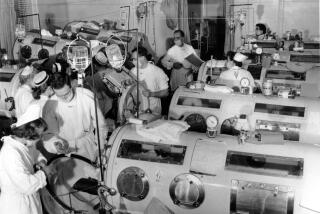Virologist pioneered engineered vaccines
Howard L. Bachrach, the virologist who purified the polio and foot-and-mouth disease viruses and was the first to use genetic engineering to produce a vaccine, died June 26 in Atlantis, Fla. He was 88 and had been suffering from heart disease, according to his daughter, Eve.
His work on purification of the polio virus made possible the development of the vaccine against the disease by Dr. Jonas Salk, according to virologist George Vande Woude, director of the Van Andel Research Institute in Grand Rapids, Mich.
Isolation of the foot-and-mouth virus could have also led to a whole-virus vaccine, Vande Woude said, but the federal government chose not to pursue it at the time.
The U.S. had suffered several devastating outbreaks of foot-and-mouth disease early in the 20th century, the last one in 1929, before the virus was effectively eradicated here.
After World War II, however, the disease reappeared in Mexico and was spreading rapidly.
The U.S. Department of Agriculture began a crash program to protect the U.S. livestock industry against its reappearance.
One of its actions was to send Bachrach, newly graduated with a doctorate in biochemistry from the University of Minnesota, to Europe to spend a year in the agency’s European Commission on Foot-and-Mouth Disease laboratories.
Working there, in 1950, he isolated and purified the virus that causes the disease.
Returning to the states that year, he accepted an appointment at the University of California’s Virus Laboratory in Berkeley, where he worked with Nobel Laureate Wendell Meredith Stanley.
At that time, researchers were trying to isolate the polio virus, which was responsible for widespread outbreaks of the debilitating disease. The polio virus is a picornavirus, like the foot-and-mouth disease virus, and Bachrach was able to apply the knowledge he had gained to the new problem.
Until then, the purest sample of polio available was only 1% virus and 99% “gunk” from the cells used to grow it.
Bachrach and virologist Carleton E. Schwerdt were able to grow the Type II, or Lansing, strain of the virus in the nerve tissues of rats and got the concentration up to about 10%.
They isolated two types of particles, one about a millionth-of-an-inch wide and a second less than half that size. Injecting the particles into rats, they demonstrated that the larger particles were the virus.
Bachrach used the electron microscope at Berkeley to take the first pictures of the virus.
The purification procedures developed by Bachrach and Schwerdt were used to produce large mounts of virus for study and to produce vaccines that were free of side effects caused by contaminants.
In 1953, Bachrach was offered an appointment to USDA’s Plum Island Animal Disease Research Center in Greenport, N.Y., where he spent the rest of his career.
One of his key discoveries there was that proteins from the surface of the foot-and-mouth disease virus, known as capsids, could produce an immune response in humans and animals even though the capsids are not infectious and do not produce disease.
Working with researchers from Genentech Corp., he was able to use genetic engineering techniques to incorporate the capsid proteins into carrier molecules, producing the first effective vaccine made with genetic engineering techniques.
For that work and other research, he was awarded the National Medal of Science in 1983.
Bachrach was born May 21, 1920, in Faribault, Minn. After earning a bachelor’s degree in chemistry in 1942 from Minnesota, he joined the war effort by performing research on chemical explosives and, later, ways of preventing bread from going stale.
After the war, he returned to the university and studied the virus that causes cholera in hogs, a disease that cost the swine industry millions of dollars each year. He demonstrated that the disease is caused not only by the virus but also by a protein that it produces.
In 1961, he was made chief scientist at Plum Island.
He formally retired in 1981 but continued working there and as a consultant until health problems made it impossible for him to continue.
Bachrach is survived by his wife of 65 years, the former Shirley F. Lichterman; his daughter, Eve, of Washington, D.C.; a son, Harrison, of Tempe, Ariz.; and a grandson.
--






